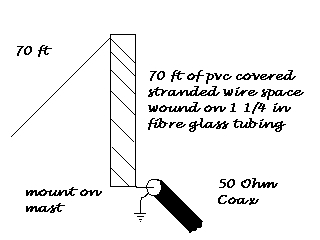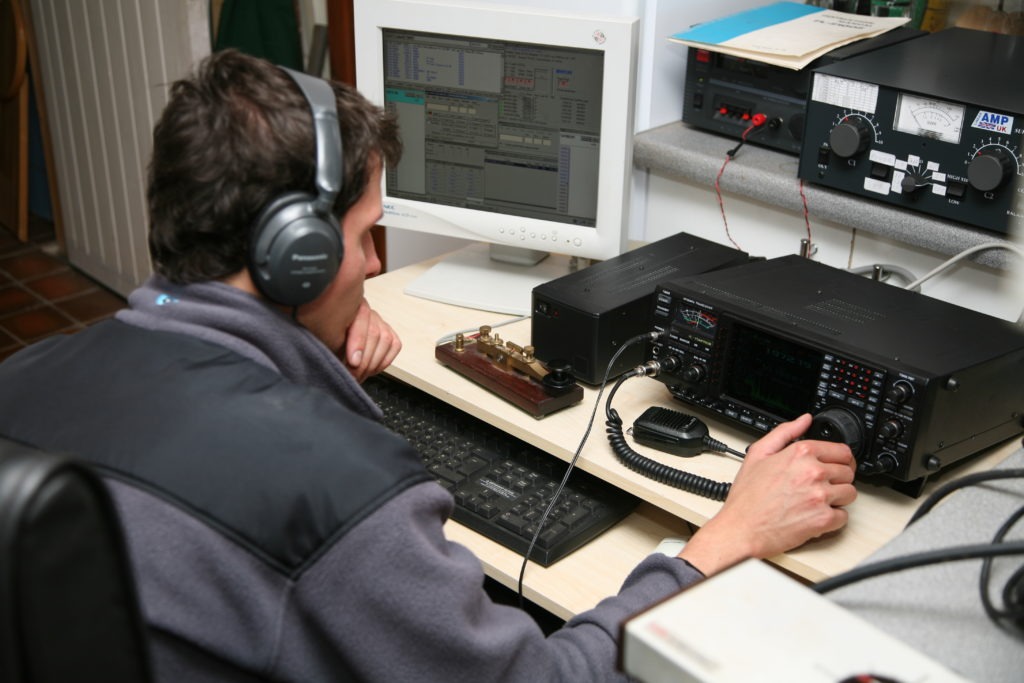Malá, ľahká, jednoduchá, praktická… Takto si predstavoval svoju anténu na 160 m Alan, G4ERZ. Do akej miery sa mu to podarilo, posúďte sami.
Rozmery a tvar antény

Izolovaný drôt dĺžky 42,6 m rozdelil pomyselne na dve časti a prvých 21,3 m jednoducho navinul na trubku z izolantu. V jeho prípade to bol sklolaminát, môžeme však skúsiť aj napr. novodurovú trubku, prípadne inštalačnú trubku s obchodným názvom Hostalen. Priemer a dĺžka závisia od našich podmienok, ale majme prosím na pamäti, že čím bude trubka dlhšia, t.j. drôt bude navinutý na väčšej dĺžke, tým bude naša anténa mať priaznivejšie vyžarovacie parametre. Nebudeme teda snažiť navinúť túto polovicu drôtu zbytočne na 50 cm kolík, keď môžeme na streche nášho domu bezpečne ukotviť napr. 5 m dĺžky. V oboch prípadoch bude tento úsek antény mať veľmi nepriaznivý vplyv na vyžarovacie parametre, predovšetkým na účinnosť celého systému, ale v prípade 5 m trubky bude naša anténa podstatne použiteľnejšia. Odporúčam zachovávať medzery medzi závitmi rovnako široké, ako je priemer vinutého drôtu.
Druhá časť z dĺžky 42,6 m je potom natiahnutá šikmo zo strechy smerom k zemi tak, aby končila približne vo výške 3–4 m nad zemou. Mala by plniť funkciu kapacitného zaťaženia a jej poloha nie je kritická.
Napájanie koaxiálnym káblom 50 ohmov
Systém je napájaný koaxiálnym káblom 50 ohmov v päte vertikálne umiestnenej vinutej časti, kde nesmieme zabudnúť na dobrú protiváhu. V tomto prípade platí, že čím viac, tým lepšie. Zlepšenie zemného systému u takejto antény jednoznačne vedie k zlepšeniu správania celého systému, ktorý má v tomto prípade polarizáciu vertikálnu aj horizontálnu a musí byť naladený do rezonancie ako celok.
Šírka pásma
Šírka pásma je podľa Alana cca 30 kHz od rezonancie pre použiteľné SWR. Alan experimentoval s anténou aj so zemným systémom a dospel k všeobecne známemu: na kvalite zemného systému priamo závisí výsledná kvalita, resp. funkcia celej antény. On sám použil dva 42 m dlhé vyzdvihnuté, naladené radiály. To vykonáme jednoducho tak, že dva radiály proti sebe ladíme do rezonancie na požadovanom kmitočte, ako by to bol nízko nad zemou ležiaci dipól. Potom ich spojíme a tento bod pripojíme v mieste napájania antény na studený koniec napájacieho kábla.
Sumár
Samozrejme ide o náhradnú anténu a na pásme to nebude žiadny zázrak, ale ak máte okolo seba iba niekoľko málo metrov voľnej plochy, práve táto anténa vás dostane na 160 m. Záleží už len na vás, do akej miery si vyhráte so zemným systémom, ktorý nemusí byť veľmi rozmerný. V núdzi sa môžeme držať pravidla: „radšej zakopeme 40 × 15 m dlhých radiálov než 1 × 80 m dlhý radiál.“
73, Petr OK1RP
